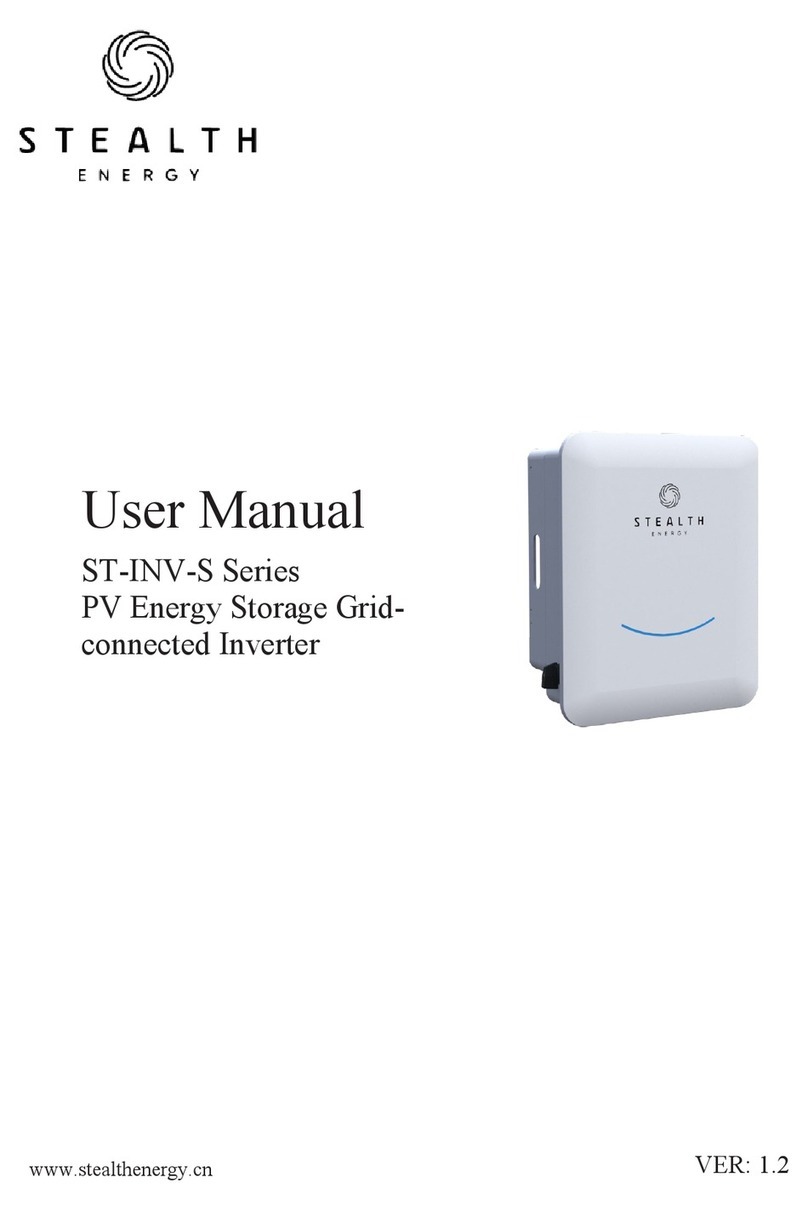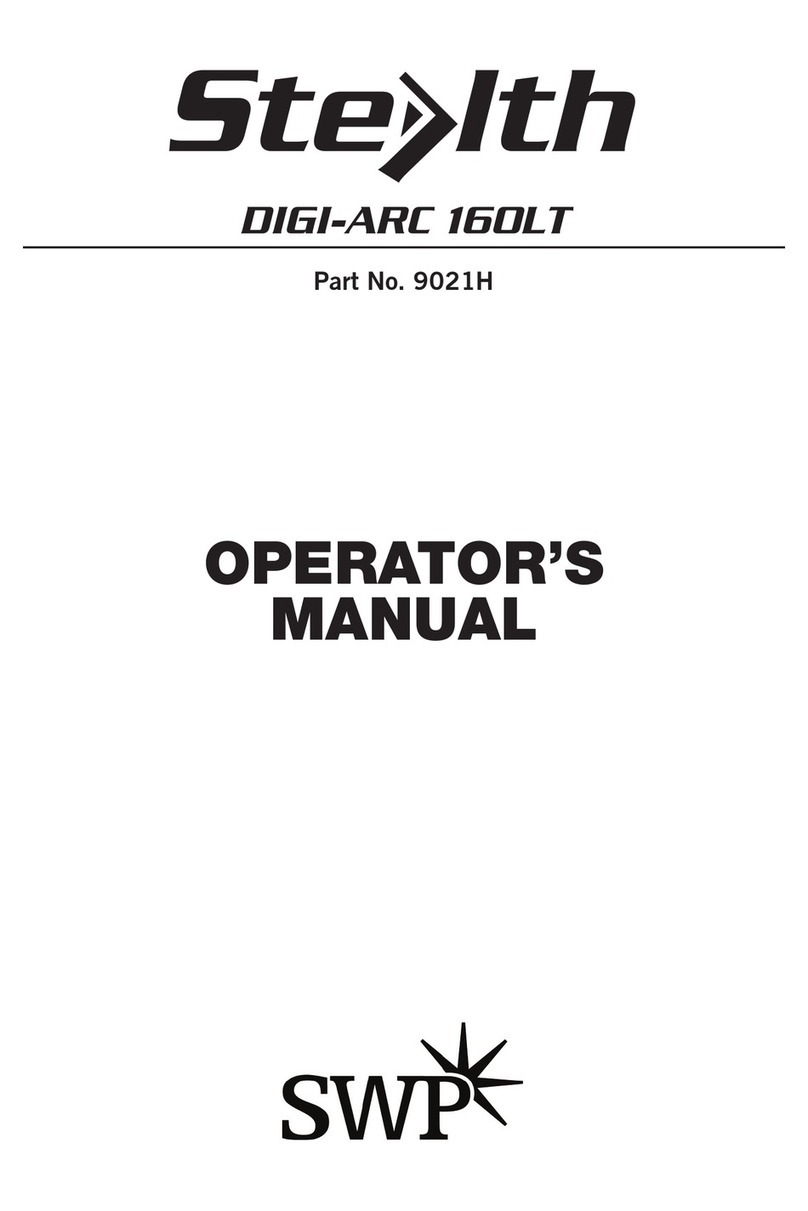
User Manual User Manual
8 9
OperationModeIntroduction
NOTICE
The above introduction describes the general working of a photovoltaic
system. The operation mode can be adjusted according to the system layout
on the Stealth Cloud App. The following are the general operating modes of
photovoltaic energy storage systems.
Depending on your configuration and layout conditions, PV energy storage
systems typically have the following modes of operation:
MODE_ Ⅰ SelfUse
Theself-usemodeissuitableforareaswithlowfeed-in
subsidiesandhighelectricityprices.
①WhenthepowerofPVissucient
ActiveChargingorDischargetimeperiod:PVwillpowerthe
loadsrstly,andsurpluspowerwillchargetothebattery.
Ifthebatteryisfullycharged,thensellthesurpluspowerto
thegrid;
(PV > Load,PV→ Load → Battery→Grid)
②WhenthepowerofPVisinsucient
ActiveChargingtimeperiod:PVwillpowertheloadsfirstly
,theremainingpowerwillbetakenfromthegrid,thebattery
willnotdischargeatthistime.
(PV < Load,PV+Grid→Load)
ActiveDischargetimeperiod:PV+BATwillpowertheloads
together.Ifthepowerisstillnotenough,theremaining
powerwillbetakenfromthegrid.
(PV < Load,PV+Battery+Grid→Load)
MODE_ Ⅱ Feed-in priority
TheFeed-inprioritymodeissuitableforareaswithhigh
feed-insubsidies,buthasfeed-inpowerlimitation.
① WhenthepowerofPVissucient
ActiveChargingtimeperiod:First,PVsupplypowertothe
load,thenchargethebatterytothesetcapacity,andthen
sellthepowertothegrid.Ifthelocalgridcompanylimits
thegrid-connectedpoweroftheinverter,theexcessenergy
continuestochargethebattery.
(PV > Load,PV→Load→Battery →Grid→Battery)
ActiveDischargetimeperiod:PVwillpowertheloadsrstly,
andsurpluspowerwillfeed-intothegrid.
(PV > Load,PV→Load→Grid)
② WhenthepowerofPVisinsucient
ActiveChargingtimeperiod:PVwillpowertheloadsrstly,
theremainingpowerwillbetakenfromthegrid.Thebattery
willnotdischarge.
(PV < Load,PV+Grid→Load)
Dischargetimeperiod:PV+BATwillpowertheloadstogether.
Ifthepowerisstillnotenough,theremainingpowerwillbe
takenfromthegrid.
(PV < Load,PV+Battery+Grid→Load)
③ WithoutPVpower
ActiveChargingtimeperiod:Thegridwillpowerthehome
loadsandalsochargethebattery;
(PV=0,Grid→Load+Battery)
ActiveDischargetimeperiod:Thebatterywillpowerthe
homeloadsfirstly.Ifthebatterypowerisnotenough,the
remainingpowerwillbetakenfromthegrid.Theinverterwill
enterintothestandbystate.
(PV=0,Battery+Grid→Load)
BatteryminSOCcanbeset:10%-100%
ChargebatterytominSOCcanbeset:10%-100%
STEALTH ST-INV-T10.0, series, also known as hybrid or bidirectional solar inverters,
is suitable for solar systems with PV, battery, load and grid systems for energy
management. The energy generated by the photovoltaic system.
The power is first used to provide the load, the excess power can be used to
charge the battery, and the remaining power can be used for grid connection.
When the PV power is not sucient to meet the requirements, the battery should
be discharged to support the load consumption. If both photovoltaic power and
battery power are insucient, the system will use grid power to support the load.
2.4 Working mode
1
2
3
1
2
③WithoutPVpower
ActiveChargingtimeperiod:Thegridsuppliestheloads
andalsocanchargethebattery;
(PV=0,Grid→Load+Battery)
ActiveDischargetimeperiod:Thebatterywillpowerthe
homeloadsörstly.Ifthebatterypowerisnotenough,the
remainingpowerwillbetakenfromthegrid.Theinverter
willenterintothestandbystate.
(PV=0,Battery+Grid→Load)
BatteryminSOCcanbeset:10%-100%
ChargebatterytominSOCcanbeset:10%-100%
1
23
1
2































